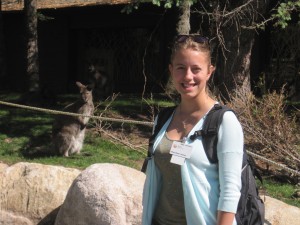 Julie Beaudin-Judd
Julie Beaudin-Judd
MSc. Student
Contact Information
Department of Biology
Concordia University (Loyola Campus)
7141 Sherbrooke St. W. H4B 1R6
Montreal, QC, Canada
Office: SP301.16
Lab: SP434
(514) 848-2424 (ext. 4021)
Education
2015-Present: MSc. Biology at Concordia University, Montreal, QC
2011-2014: BSc. Animal Health and Disease (Life Sciences) at McGill University, Montreal, QC
My Project
Impact of open exhibit concept on captive animal behaviour and welfare, and on the visitor’s perception: the case of Bennett’s wallabies (Macropus rufogriseus)
Background
Concordia University and the Granby Zoo have begun a long-term collaboration with the aim of improving knowledge about their captive animals and how the zoo can improve their living conditions. A number of research projects will be implemented and they will be applied with the objective of improving and benefitting the zoo, captive animal welfare, and visitor experience.
The welfare of zoo-housed animals has been an ongoing issue for many decades now. For that reason, zoo exhibit designs have undergone many changes through time, shifting away from the original small barred cages, to more complex and natural settings. A particular design that can increasingly be found in zoos is the free-range, open exhibit where physical interaction is possible with human visitors. Whether the human-animal interaction possible in these exhibits is beneficial to the captive species is still a question being investigated. Our research will provide further insight on this question and additionally on how visitors perceive these exhibits. Two different zoo settings will be studied for comparison: 1-No available contact between animals and visitors possible (closed, fenced exhibit); 2-Animals can cross visitor paths if they choose to but the contrary is not possible (open/walkthrough exhibit).
This comparative study will enable scientists as well as Zoo members to gain further insight regarding what levels of interaction with humans is optimal for the well-being and happiness of captive wallabies, while also enriching the visitors’ experience as much as possible. The resulting conclusions of this study will also be applicable to other species exhibited in similar enclosure designs and will contribute to future exhibit development across different zoological institutions.
Field Work
This research will mainly take place at the Zoo de Granby (QC), but also Riverview Park and Zoo (ON) and Roger Williams Park Zoo (RI, USA). The two planned data collection field seasons will be in the summers of 2015 and 2016. Field work will consist of collecting behavioural data of captive Bennett’s wallaby populations in two open and two closed exhibits. Moreover, surveys will be distributed to zoo visitors to evaluate their preferences, experience and perception of the different exhibit designs.
Objectives
The main objective of this study is to evaluate the impact open exhibit designs have on the behaviour and welfare of captive Bennett’s wallabies, and also on the experience of zoo visitors. In order to gain insight on the impact of this open design we will:
- Study the activity budget of captive Bennett’s wallabies and use it as a means of comparison and welfare assessment in open versus closed exhibit designs
- Compare zoo visitor surveys completed after visiting the different studied exhibits to assess visitor perception, preferences and experience
Publications
- Beaudin-Judd J.*, Weladji RB., Paré, P. (2015) Impact of the open exhibit design on the activity budget of captive Bennett’s wallabies (Macropus rufogriseus) . 40e congrès annuel pour la Société Québecoise pour l’Étude Biologique du Comportement, 6-8 Novembre, 2015, Quebec City, Quebec, Canada (poster presentation).





